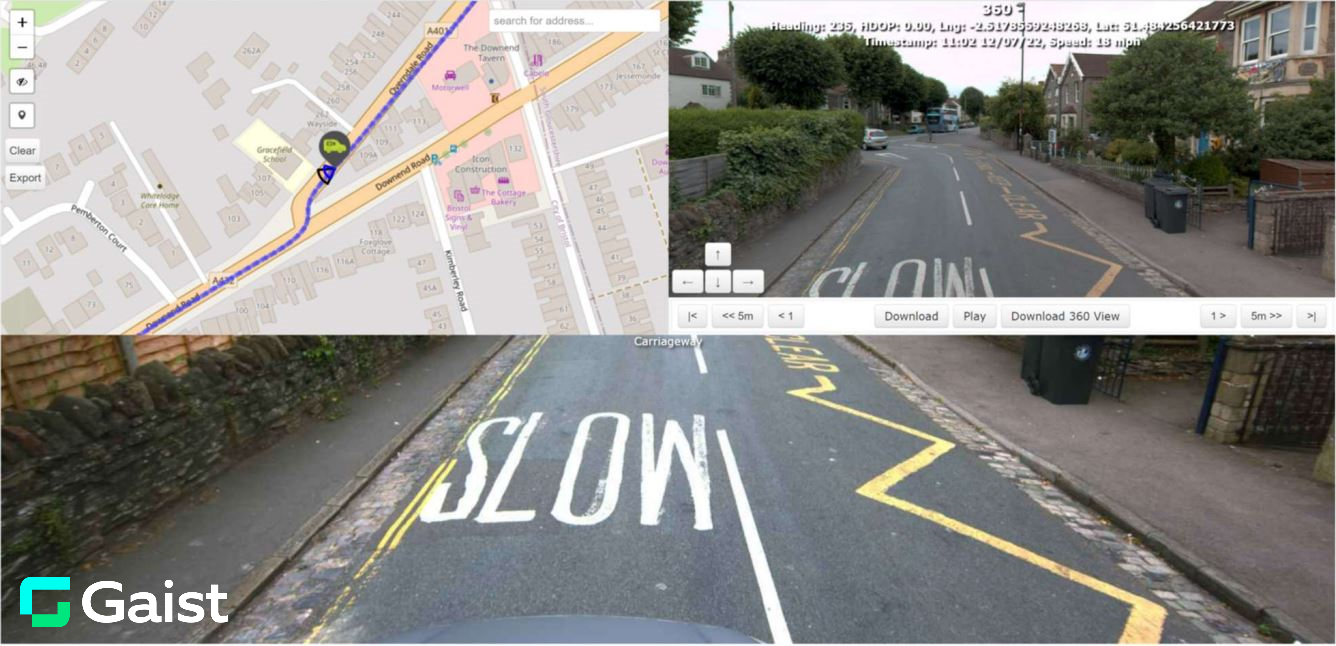Early Findings from the Aisin Mobility and Gaist partnership
Following the launch of the joint offer between Gaist and Aisin-Mobility, three local authority early adopters have already been confirmed and many others are actively exploring the possibilities for using RoadTrace™ insights to benefit their highways safety and maintenance provision.
We thought it might be interesting to share some of the anonymised results of these initial conversations to shed some light on the early findings. One of the key strengths of Aisin’s Roadtrace™ connected car insights combined with Gaist’s high-definition imagery is the ability to complement forensic road condition data with the actual impact on drivers in a real-world context. To that end we have been able to show highways managers insights on their actual road network and the results have been illuminating.
Keeping Schools Safe
Take this example:
The input data reveals over 11,000 instances of harsh braking every month, just in this one city. The RoadTrace™ technology then filters and prioritises that data to reveal safety-critical “hot-spots” where there are clusters of drivers engaging in emergency braking.
One such hot-spot was identified in front of a school.
This was no surprise to the highways manager as it took place outside a school, an area in which harsh braking is not uncommon.
In this particular scenario the potential causes of harsh braking were able to be identified rapidly from the insights provided which were given real world context by the 360-degree HD imagery, as if a visual inspector was guided exactly to the area for investigation with an assessment able to be made in minutes. It was quickly realised that signage and visibility of road markings could be significant contributing factors to harsh braking in that area.
Aligning Safety Information
Take this second example, it was immediately apparent from the Harsh Braking Cluster (left image) and linked imagery (right image) that there was a sharp turn at the end of the road and narrow roads. The 360-degree panoramic imagery enabled the local authority to see that limited visibility and crossing traffic compounded the safety issue, providing context to the harsh braking patterns that the Roadtrace™ connected car insights had flagged.
Added Value
Alongside verification of local knowledge within a local authority and highlighting areas of investigation that may be unknown to them, in both cases preventing further road accidents, our work with the early adopters has provided further use cases for the areas of investigation flagged by connected cars.
It quickly became apparent that the data insights could also be used for prioritising maintenance schemes in grey areas on the network. The question repeatedly arose as to how you prioritise areas with inconclusive data to maximise road safety outcomes with limited resources at your disposal.
With the harsh braking insights, combined with high-definition imagery and key contextual data provided by the partnership it became apparent we can prioritise those areas for further investigation and maintenance which is of huge benefit to those responsible for maintenance. The addition of behavioural information alongside the 360-degree imagery gives a deeper insight in to where the bigger safety risks really are on a local road network.
Additionally, these outputs give maintenance and safety professionals a robust, evidence-based solution to the challenge of communicating to council members the rationale for their maintenance prioritisation. With the insights provided by the partnership it becomes much easier to communicate how you allocate resources in a methodical, evidence-based fashion to the wider public and elected members.
Continual Development
In keeping with Gaist’s history of working collaboratively with local authorities, our partnership-first approach compels us to continually develop a product designed for highways safety managers (and other related stakeholders) to further refine the outputs tailored to their specific needs.
To that end we will be layering accident zones and integrating KSI statistics to enrich the insights provided by the Gaist-Aisin partnership alongside ensuring cross-integration with existing Gaist road condition analysis and public complaints.
Though each UK highways authorities needs are different and the insights from this partnership can be integrated in existing safety provision, it can already be seen there are specific, robust use cases for the data which will make a meaningful impact to road safety in local areas.
Later in the year we will be hosting a webinar with local authority early adopters to go in to even more depth on how the Gaist-Aisin partnership datasets have been used to maximise positive road safety outcomes- look out for more information in the coming months.
For more information contact Lorna Payne, Business Development Manager at Aisin on lorna.payne@aisin-europe.com




